
Home
Home
About Geosun
About Geosun
Products
Products
- Hardware
- Mobile LiDAR Scanning System
- gCollector Road Information Collection System
- gSpin POS System
- PPK Solution
Support
Support
News
News
Contact Us
Contact Us

In the ever-evolving field of surveying, professionals have two main types of instruments at their disposal: traditional optical surveying instruments, like Total Stations, and modern satellite-based tools, such as GNSS RTK receivers. Deciding which tool to use can depend on various factors. This blog will explore the key differences between Total Stations and GNSS RTK receivers to help you make an informed choice.

Light Conditions: A Total Station, an advanced version of theodolites, measures distances, coordinates, and elevations using visible light. Adequate light is essential as the device relies on the human eye to aim at the target. Poor lighting can hinder the accuracy of measurements due to visibility issues.
Line of Sight: Total Stations require a clear line of sight between the instrument and the target. Any obstructions can impede both the human operator’s view and the instrument’s ability to collect data, affecting the accuracy and feasibility of the measurement.
Line of Sight: RTK systems do not require a direct line of sight since they rely on satellite signals. As long as the receiver can connect to satellites, it will function effectively, even in challenging environments where visibility is restricted.
Wireless Connectivity: RTK systems use radio signals or network connections for communication. Base and rover stations can connect through an external radio or a SIM card, facilitating wireless data exchange.
Typically suited for short-range measurements, with a maximum range of about 1.5 kilometers. Without a prism, the range is limited to around 1000 meters. For distant points, multiple setups are necessary, which can be time-consuming and may introduce measurement errors.
Capable of measuring distances up to around 10 kilometers, with the potential for greater distances depending on the transmitter’s power. RTK systems only require a single setup of the base station for efficient measurement over large areas.
Requires multiple setups to complete a task, with each setup potentially introducing measurement errors. Error propagation can lead to significant inaccuracies, especially with numerous relocations.
Offers high precision by measuring relative positions between the base and rover stations. Accuracy is typically within 1 cm + 1 ppm of the distance, minimizing error accumulation. This differential measurement approach ensures reliable results with minimal error propagation.
Typically requires three operators: one to observe, one to measure, and one to record data. This can be less efficient and more labor-intensive.
Requires only two operators: one to manage the base station and one to operate the rover. This reduces manpower requirements and increases efficiency.
Layout tasks require communication via walkie-talkie to direct the prism, which can be less efficient and slower.
Offers greater efficiency by displaying direction, distance differences, azimuth, and elevation changes on a handheld device. This allows for quicker and more accurate layout tasks, often achievable by a single operator.
In summary, GNSS RTK receivers provide enhanced convenience and efficiency, often requiring fewer personnel and offering greater measurement range and accuracy for large-scale projects. However, Total Stations are indispensable for high-precision tasks, such as indoor surveys or complex bridge projects. Choosing the right equipment depends on the specific requirements of your project and your operational preferences.

With technological advancements, the handheld RTK LiDAR scanner is gaining prominence now. GNSS RTK technology can struggle with accuracy in environments like high-rise buildings, mountains, and canyons. In urban settings, tall buildings often block GNSS signals, leading to decreased positioning accuracy. Handheld RTK LiDAR, however, is not affected by GNSS signal issues and can deliver centimeter-level precision in diverse environments. LiDAR (Light Detection and Ranging) measures distances by emitting lasers and timing their reflections, which makes it unaffected by obstacles like buildings and varying terrain. This results in superior performance in complex environments such as cityscapes, mountains, and canyons. Additionally, LiDAR provides detailed three-dimensional spatial data, which is invaluable for applications needing precise terrain information. Consequently, for high-precision tasks such as urban planning and topographic surveys, handheld RTK LiDAR offers a robust alternative, ensuring more reliable and accurate positioning. Its resistance to GNSS signal interference makes it especially effective in urban environments.
URL:https://www.geosuntech.com/News/232.html
Previous:Small Size, Big Impact | Handheld LiDAR: Precision for the Digital Age
Next:Handheld SLAM LiDAR vs Terrestrial LiDAR: A Comprehensive Comparison




